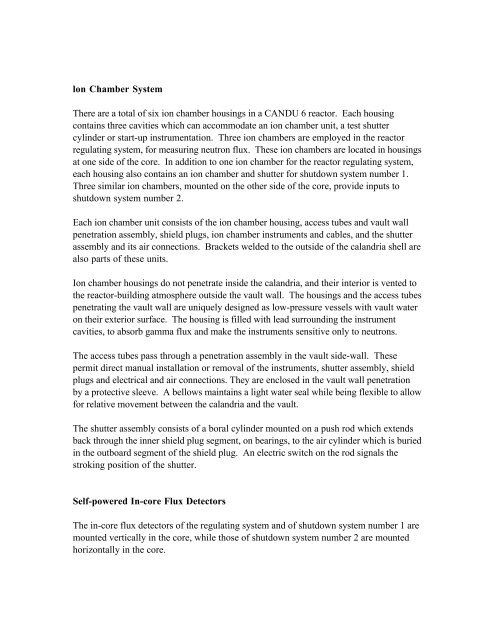Reactor Core Structure of Qinshan Phase III CANDU Nuclear Power ...
Reactor Core Structure of Qinshan Phase III CANDU Nuclear Power ...
Reactor Core Structure of Qinshan Phase III CANDU Nuclear Power ...
Create successful ePaper yourself
Turn your PDF publications into a flip-book with our unique Google optimized e-Paper software.
lon Chamber System<br />
There are a total <strong>of</strong> six ion chamber housings in a <strong>CANDU</strong> 6 reactor. Each housing<br />
contains three cavities which can accommodate an ion chamber unit, a test shutter<br />
cylinder or start-up instrumentation. Three ion chambers are employed in the reactor<br />
regulating system, for measuring neutron flux. These ion chambers are located in housings<br />
at one side <strong>of</strong> the core. In addition to one ion chamber for the reactor regulating system,<br />
each housing also contains an ion chamber and shutter for shutdown system number 1.<br />
Three similar ion chambers, mounted on the other side <strong>of</strong> the core, provide inputs to<br />
shutdown system number 2.<br />
Each ion chamber unit consists <strong>of</strong> the ion chamber housing, access tubes and vault wall<br />
penetration assembly, shield plugs, ion chamber instruments and cables, and the shutter<br />
assembly and its air connections. Brackets welded to the outside <strong>of</strong> the calandria shell are<br />
also parts <strong>of</strong> these units.<br />
Ion chamber housings do not penetrate inside the calandria, and their interior is vented to<br />
the reactor-building atmosphere outside the vault wall. The housings and the access tubes<br />
penetrating the vault wall are uniquely designed as low-pressure vessels with vault water<br />
on their exterior surface. The housing is filled with lead surrounding the instrument<br />
cavities, to absorb gamma flux and make the instruments sensitive only to neutrons.<br />
The access tubes pass through a penetration assembly in the vault side-wall. These<br />
permit direct manual installation or removal <strong>of</strong> the instruments, shutter assembly, shield<br />
plugs and electrical and air connections. They are enclosed in the vault wall penetration<br />
by a protective sleeve. A bellows maintains a light water seal while being flexible to allow<br />
for relative movement between the calandria and the vault.<br />
The shutter assembly consists <strong>of</strong> a boral cylinder mounted on a push rod which extends<br />
back through the inner shield plug segment, on bearings, to the air cylinder which is buried<br />
in the outboard segment <strong>of</strong> the shield plug. An electric switch on the rod signals the<br />
stroking position <strong>of</strong> the shutter.<br />
Self-powered In-core Flux Detectors<br />
The in-core flux detectors <strong>of</strong> the regulating system and <strong>of</strong> shutdown system number 1 are<br />
mounted vertically in the core, while those <strong>of</strong> shutdown system number 2 are mounted<br />
horizontally in the core.
















